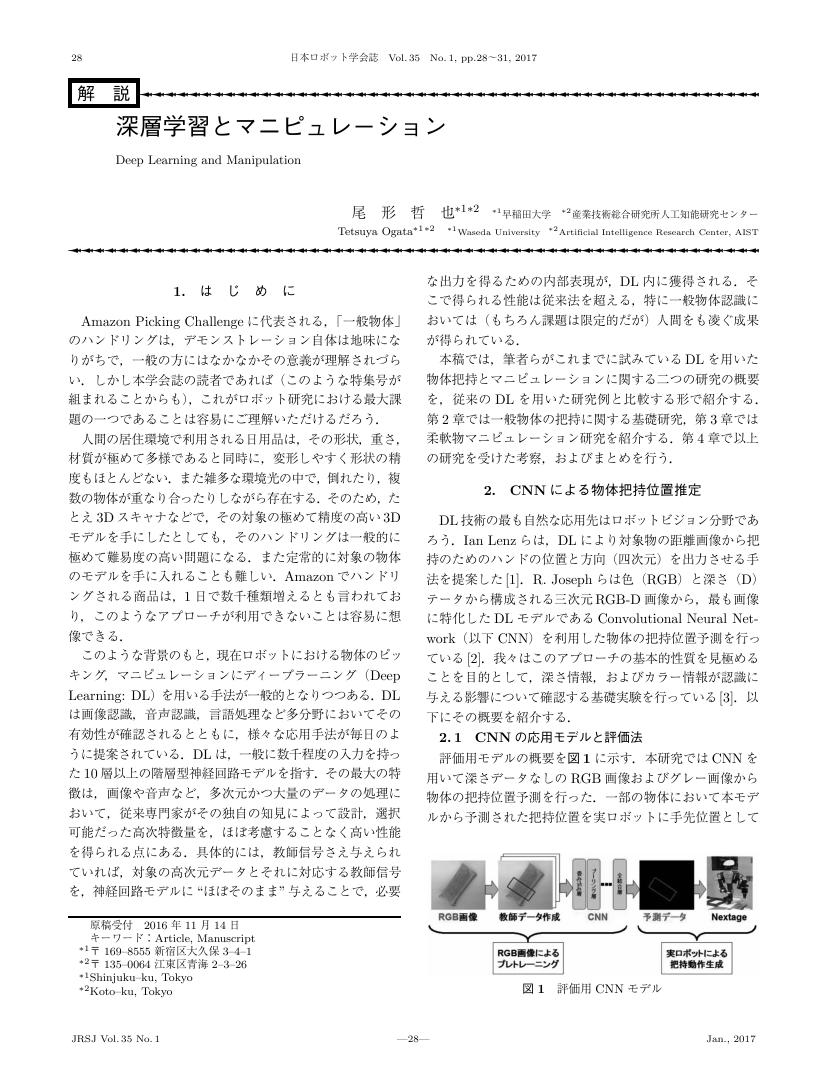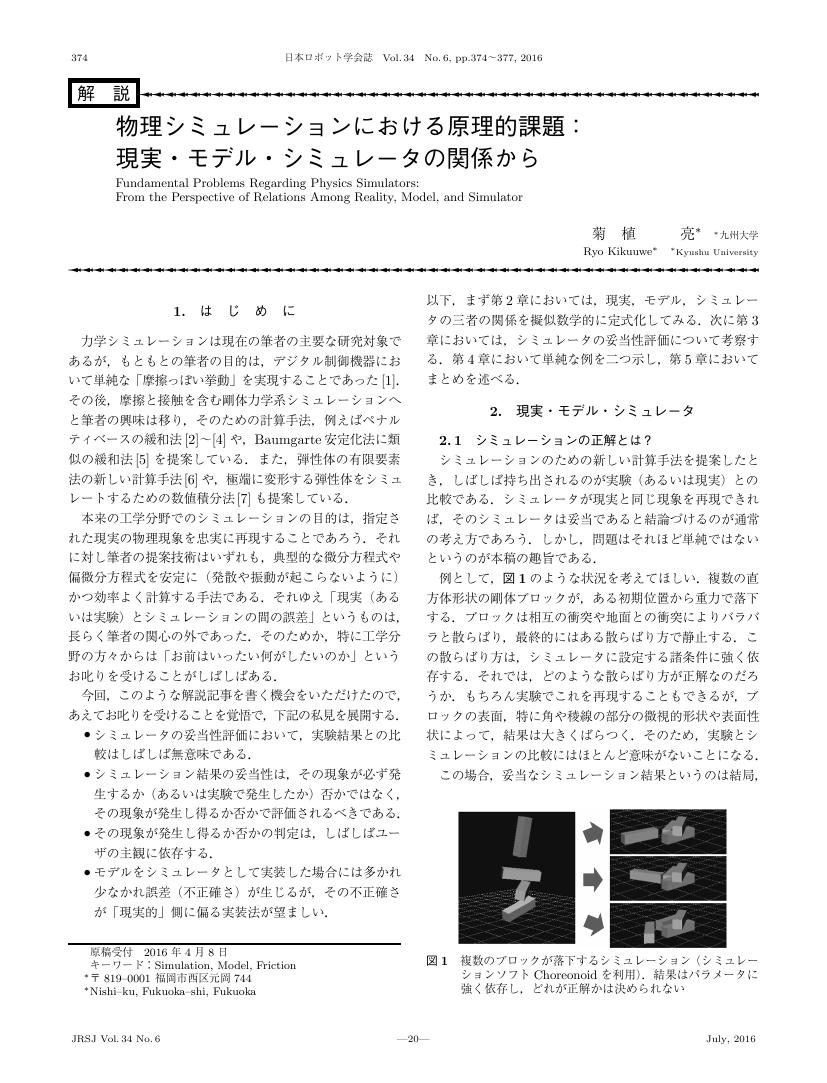1 0 0 0 OA 深層学習とマニピュレーション
- 著者
- 尾形 哲也
- 出版者
- 一般社団法人 日本ロボット学会
- 雑誌
- 日本ロボット学会誌 (ISSN:02891824)
- 巻号頁・発行日
- vol.35, no.1, pp.28-31, 2017 (Released:2017-02-15)
- 参考文献数
- 9
- 被引用文献数
- 6 4
1 0 0 0 生物を規範として使い物になるソフトロボットを作る
- 著者
- 梅舘 拓也
- 出版者
- 一般社団法人 日本ロボット学会
- 雑誌
- 日本ロボット学会誌 (ISSN:02891824)
- 巻号頁・発行日
- vol.37, no.1, pp.12-15, 2019
<p></p>
1 0 0 0 OA 深層予測学習によるロボット動作学習 —エクスペリエンス・ベースド・ロボティクス—
- 著者
- 尾形 哲也
- 出版者
- 一般社団法人 日本ロボット学会
- 雑誌
- 日本ロボット学会誌 (ISSN:02891824)
- 巻号頁・発行日
- vol.38, no.6, pp.516-520, 2020 (Released:2020-07-29)
- 参考文献数
- 10
- 被引用文献数
- 1
1 0 0 0 OA 開かれた知能と機構
- 著者
- 高木 健
- 出版者
- 一般社団法人 日本ロボット学会
- 雑誌
- 日本ロボット学会誌 (ISSN:02891824)
- 巻号頁・発行日
- vol.36, no.9, pp.605-608, 2018 (Released:2018-12-15)
- 参考文献数
- 4
- 被引用文献数
- 1
1 0 0 0 OA 空気圧ゴム人工筋を用いたパワーアシストウェアの開発
- 著者
- 則次 俊郎
- 出版者
- 一般社団法人 日本ロボット学会
- 雑誌
- 日本ロボット学会誌 (ISSN:02891824)
- 巻号頁・発行日
- vol.33, no.4, pp.222-227, 2015 (Released:2015-06-15)
- 参考文献数
- 6
- 被引用文献数
- 3 3
1 0 0 0 OA ドイツのモノづくり政策Industrie 4.0が狙う製造業の標準化戦略
- 著者
- 川野 俊充
- 出版者
- 一般社団法人 日本ロボット学会
- 雑誌
- 日本ロボット学会誌 (ISSN:02891824)
- 巻号頁・発行日
- vol.33, no.5, pp.318-324, 2015 (Released:2015-07-15)
- 参考文献数
- 10
- 被引用文献数
- 2 2
1 0 0 0 OA 「さがみロボット産業特区」における生活支援ロボット普及促進の取り組みについて
- 著者
- 櫻井 正己 冨高 英樹
- 出版者
- 一般社団法人 日本ロボット学会
- 雑誌
- 日本ロボット学会誌 (ISSN:02891824)
- 巻号頁・発行日
- vol.38, no.7, pp.581-587, 2020 (Released:2020-09-05)
- 参考文献数
- 7
1 0 0 0 OA 物理シミュレーションにおける原理的課題:現実・モデル・シミュレータの関係から
- 著者
- 菊植 亮
- 出版者
- 一般社団法人 日本ロボット学会
- 雑誌
- 日本ロボット学会誌 (ISSN:02891824)
- 巻号頁・発行日
- vol.34, no.6, pp.374-377, 2016 (Released:2016-08-15)
- 参考文献数
- 10
- 被引用文献数
- 1
1 0 0 0 OA 日本ロボット学会への要請 —近未来を見据えて—
- 著者
- 森 政弘
- 出版者
- 一般社団法人 日本ロボット学会
- 雑誌
- 日本ロボット学会誌 (ISSN:02891824)
- 巻号頁・発行日
- vol.36, no.4, pp.273-277, 2018 (Released:2018-06-15)
- 参考文献数
- 7
1 0 0 0 ロボカップ戦略:研究プロジェクトとしての意義と価値
- 著者
- 浅田 稔 北野 宏明
- 出版者
- 一般社団法人 日本ロボット学会
- 雑誌
- 日本ロボット学会誌 (ISSN:02891824)
- 巻号頁・発行日
- vol.18, no.8, pp.27-30, 2000-11-15
- 参考文献数
- 8
- 被引用文献数
- 2
- 著者
- 奥井 学
- 出版者
- 一般社団法人 日本ロボット学会
- 雑誌
- 日本ロボット学会誌 (ISSN:02891824)
- 巻号頁・発行日
- vol.37, no.1, pp.57-60, 2019 (Released:2019-01-15)
- 参考文献数
- 9
1 0 0 0 OA 建設機械の遠隔操作のためのヒューマンインタフェース
- 著者
- 山田 宏尚
- 出版者
- 一般社団法人 日本ロボット学会
- 雑誌
- 日本ロボット学会誌 (ISSN:02891824)
- 巻号頁・発行日
- vol.33, no.6, pp.400-403, 2015 (Released:2015-08-15)
- 参考文献数
- 10
- 被引用文献数
- 6 4
1 0 0 0 OA 火山防災に求められるロボット技術
- 著者
- 皆川 淳
- 出版者
- 一般社団法人 日本ロボット学会
- 雑誌
- 日本ロボット学会誌 (ISSN:02891824)
- 巻号頁・発行日
- vol.38, no.3, pp.249-252, 2020 (Released:2020-05-02)
- 参考文献数
- 17
1 0 0 0 OA 暗視野顕微鏡法におけるクラミドモナスの三次元トラッキング
- 著者
- 荒井 祐介 若林 憲一 吉川 雅英 奥 寛雅 石川 正俊
- 出版者
- 一般社団法人 日本ロボット学会
- 雑誌
- 日本ロボット学会誌 (ISSN:02891824)
- 巻号頁・発行日
- vol.31, no.10, pp.1028-1035, 2013 (Released:2014-01-15)
- 参考文献数
- 16
- 被引用文献数
- 1 1
Recently, flagella and cilia have gathered attension since their important role in mammal cells and relation to genetic diseases of human were revealed. Chlamydomonas is one of the model organism of flagella and phototaxis research. The purpose of our research is to track a freely swimming individual Chlamydomonas cell to observe its flagella and whole body movement with dark field microscopy to investigate the phototactic reaction of Chlamydomonas. In this paper, a method for three-dimensional tracking of Chlamydomonas using high-speed visual feedback in dark field microscopy is proposed. The method was implemented to an existing microscope tracking system. It demonstrated successful three-dimensional tracking of a swimimng Chlamydomonas for several tens of seconds. The precisions of the 3D position measurement were estimated as ±1[μm] (XY) and ±10[μm] (Z).
1 0 0 0 OA ロボットの機能の中核をなす機巧 —バックドライバビリティを有するウォームホイール機構—
- 著者
- 多田隈 理一郎
- 出版者
- 一般社団法人 日本ロボット学会
- 雑誌
- 日本ロボット学会誌 (ISSN:02891824)
- 巻号頁・発行日
- vol.32, no.4, pp.358-362, 2014 (Released:2014-06-15)
- 参考文献数
- 6
1 0 0 0 OA 測量地図情報に基づく移動ロボットの自己位置推定法
- 著者
- 八木 秀明 星野 智史
- 出版者
- 一般社団法人 日本ロボット学会
- 雑誌
- 日本ロボット学会誌 (ISSN:02891824)
- 巻号頁・発行日
- vol.39, no.3, pp.275-278, 2021 (Released:2021-04-28)
- 参考文献数
- 7
For autonomous mobile robot navigation, localization is a fundamental technique. For this purpose, environmental maps are usually given beforehand by using SLAM. In stead of SLAM, we use an existing geographical map. Since road and building information are already included in the map, we focus on the scan data of the actual road surface and buildings in the environment obtained from a 3D LiDAR. In the map, MCL technique enables a robot to estimate the position. In the experiments, we show that the robot is able to autonomously move more stably through the localization with not only the scan data of the road surface, but also the ones of the buildings.
1 0 0 0 OA 水圧ロボットの空気–液圧サーボ増圧器による遠隔トルク制御
- 著者
- 赤間 一太 谷口 友美 玄 相昊
- 出版者
- 一般社団法人 日本ロボット学会
- 雑誌
- 日本ロボット学会誌 (ISSN:02891824)
- 巻号頁・発行日
- vol.39, no.4, pp.375-378, 2021 (Released:2021-05-25)
- 参考文献数
- 12
Water-hydraulic system is environmentally friendly technology, and its application to robot manipulators is eagerly awaited. However, they are still expensive compared to oil-hydraulic systems because of the technical problems related to fast sliding motions between the solid materials contacting each other with the very small gap in the pumps or valves. To avoid these difficulties, we proposed an alternative solution, which lead to a pump-less hydraulic system called AHSB. The system utilizes an air-hydraulic booster to control the low-to-middle range water pressure by pneumatic servo valves. In this paper, we analyze the water-hydraulic dynamics and develop a robust pressure-based joint torque controller using Sliding Mode Control. The controller is implemented on a single-axis robot arm for the remote torque control application, which is crucially important for future tele-operated field robots. The experiments under quasi-static condition demonstrates the first successful torque control results on the water-driven robot with 10 kg payload, which is connected with 20 meter-long hydraulic hoses.
1 0 0 0 OA イルカ型ロボットから水泳ヒューマノイドロボット
- 著者
- 中島 求
- 出版者
- 一般社団法人 日本ロボット学会
- 雑誌
- 日本ロボット学会誌 (ISSN:02891824)
- 巻号頁・発行日
- vol.33, no.1, pp.2-6, 2015 (Released:2015-02-15)
- 参考文献数
- 13
- 著者
- 川内 陽志生 稲葉 忠 福田 敏男
- 出版者
- 一般社団法人 日本ロボット学会
- 雑誌
- 日本ロボット学会誌 (ISSN:02891824)
- 巻号頁・発行日
- vol.12, no.1, pp.116-132, 1994-01-15
- 参考文献数
- 39
- 被引用文献数
- 6 7
This paper deals with a robotic system which is required to exhibit adaptability and have the capability of self-organization, and self-evolution. One such robotic system to realize this type of configuration has been studied by the authors. It is called a cellular robotic system (hereinafter call CEBOT) . CEBOT consists of many kinds of functional units. Each unit is called a “cell”, which possesses at least one function, and its own intelligence. The fundamental concept of CEBOT is based on biological systems which are adaptable and capable of self-organization, and self-evolution. Like the biological system, many cells can organize a structure to integrate the tiny functions of single cell. Therefore, the whole structure can execute complicated tasks which can not be carried out by a cell. This paper covers essential issues to develop a type of multi-agent robotic system as follows : the fundamental concept of CEBOT and the definition of the “cell”, the control law for cells to realize the “function amplification” which is a newly proposed concept, the hardware and the software configuration, and the optimizing method of the structure for both the hardware and the software of CEBOT.
1 0 0 0 OA World Robot Summit(WRS)の意義とWRS2018(東京大会)
- 著者
- 佐藤 知正 細谷 克己
- 出版者
- 一般社団法人 日本ロボット学会
- 雑誌
- 日本ロボット学会誌 (ISSN:02891824)
- 巻号頁・発行日
- vol.37, no.3, pp.203-207, 2019 (Released:2019-04-18)
- 参考文献数
- 4






